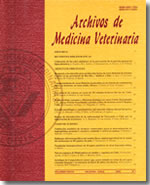Anisakid nematodes of interest in public health in fishes commercialized in Valdivia, Chile
Main Article Content
Abstract
In Chile, infection by Anisakid nematodes has been reported in humans associated with raw ("cebiche") and smoked marine fishes consumption. During 1994, 125 fresh marine fishes commercialized in markets from Valdivia, Chile, were microscopically examined for anisakids in the musculature. From the 10 species examined the following fish species were infected (n of infected/examined fishes) with Anisakis simplex (As), Pseudoterranova decipiens (Pd) and Hysterothylacium sp. (H sp.): the Chilean hake, Merluccius gayi (As 1/17; Pd 4/17), the tail-hake, Macrouronus magellanicus (Pd 1/4; H sp. 1/4), the red-conger-eel, Genypterus chilensis (Pd 9/18), the flat-fish, Paralichthys microps (As 1/10; Pd 7/10) and the Chilean mackerel, Trachurus murphyi (As 2/16; Pd 5/16). All isolated anisakid larvae were alive. The highest number of anisakid per fish (4 larvae) was detected in M. gayi and T. murphyi but the highest density, 3.3 worms/100 g of muscles, was observed in P. microps. The number of parasites was scarce, but their presence in the commercialized fishes in Valdivia, without freezing or sanitary inspection represents a potential risk.

